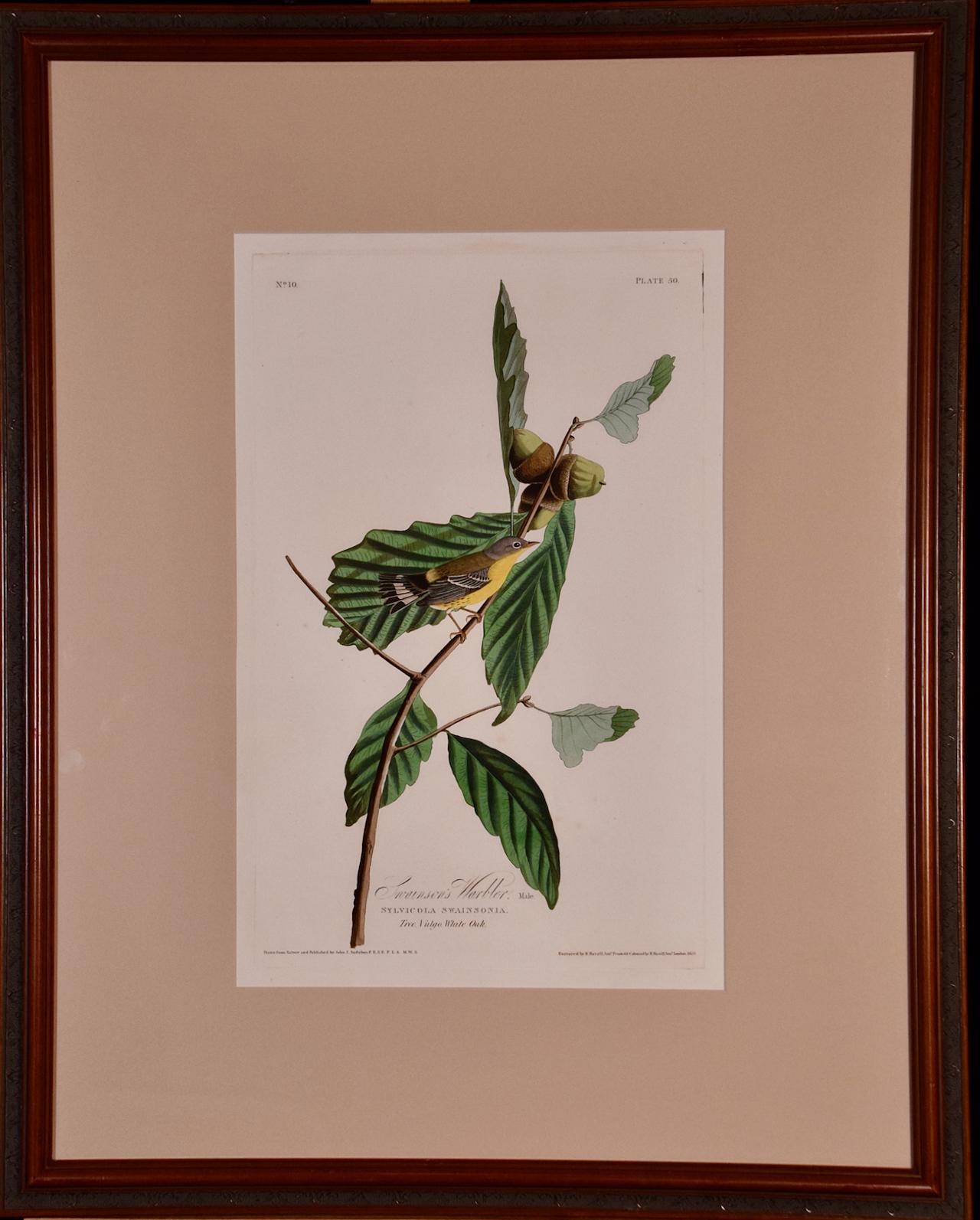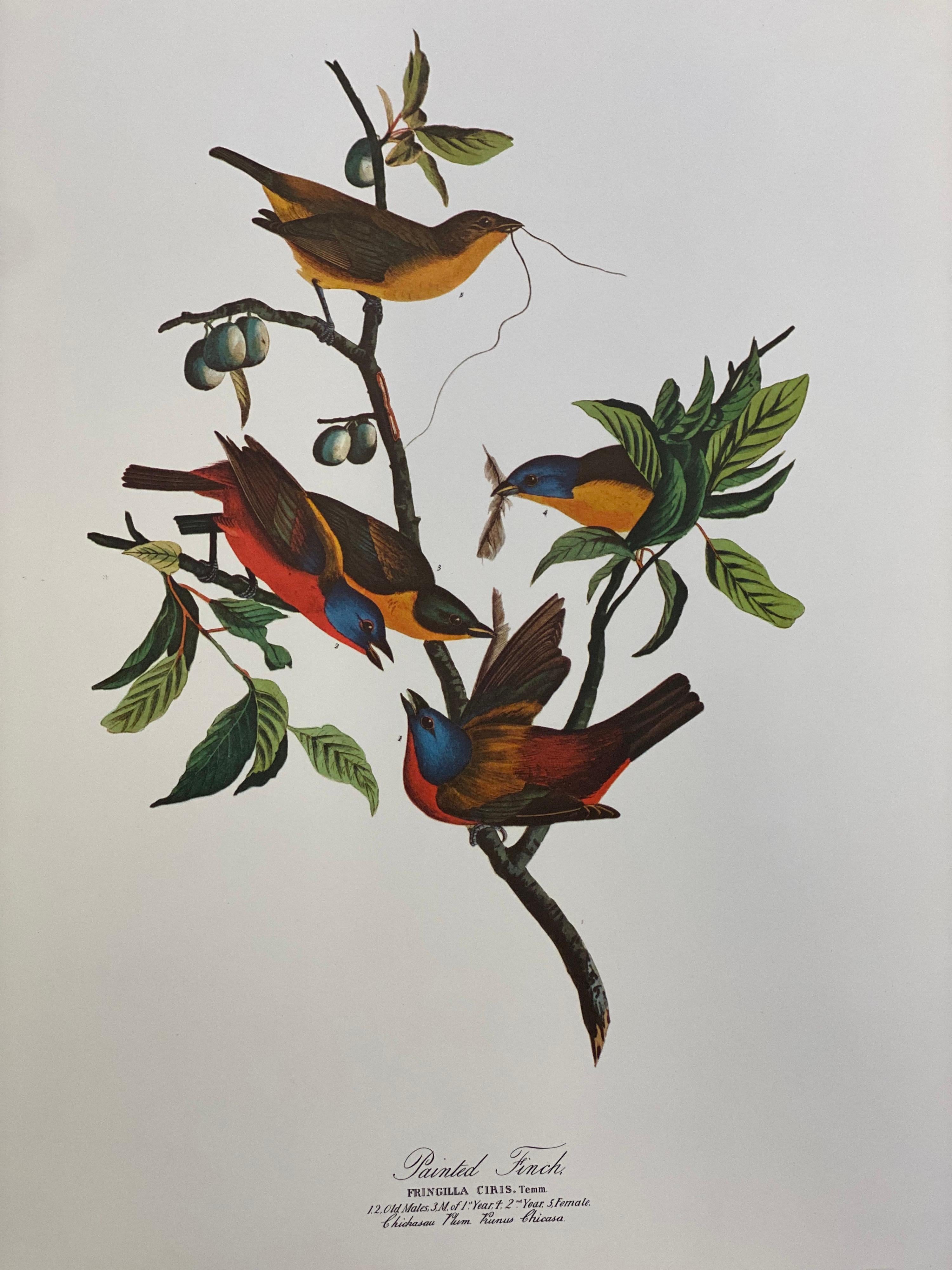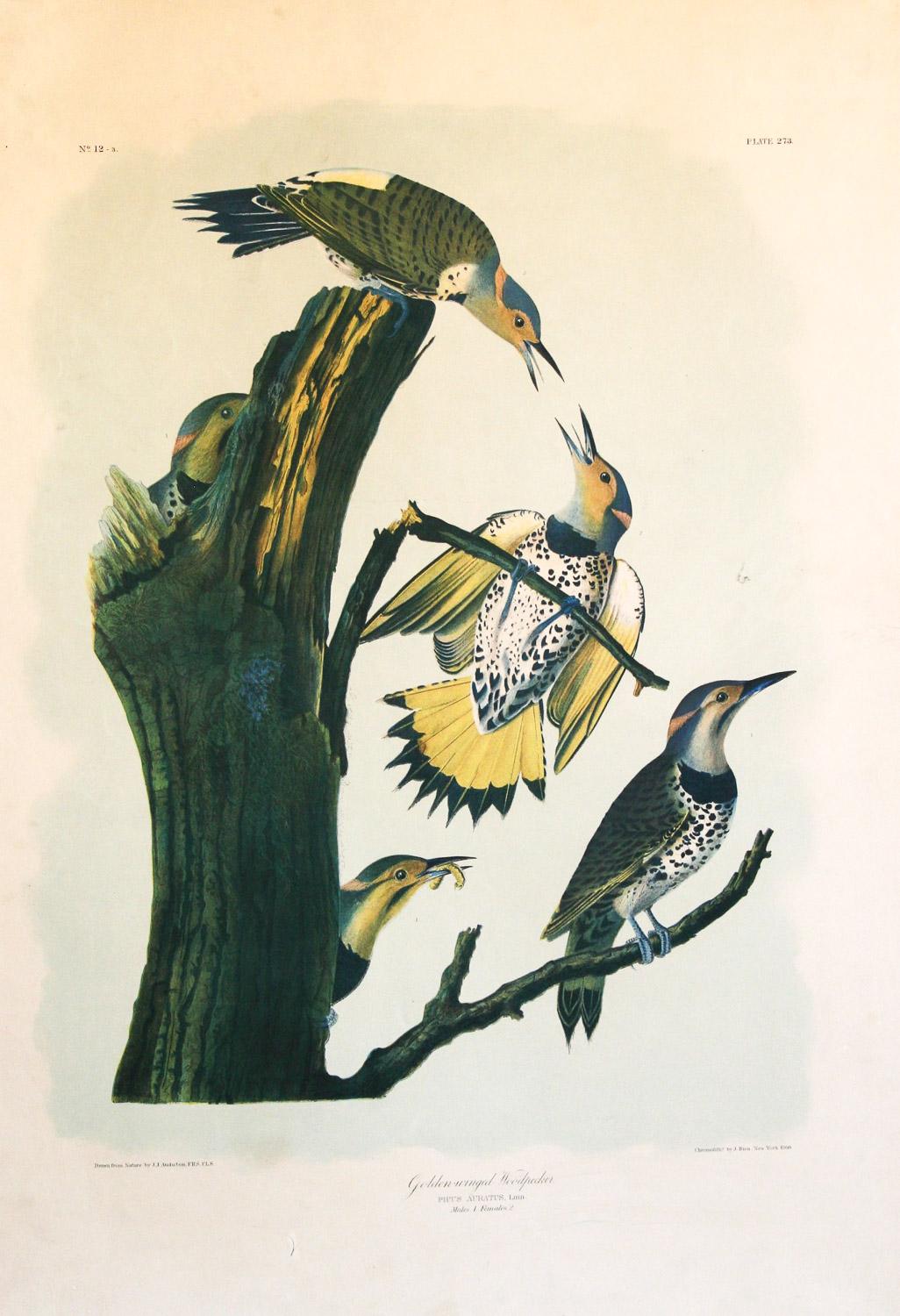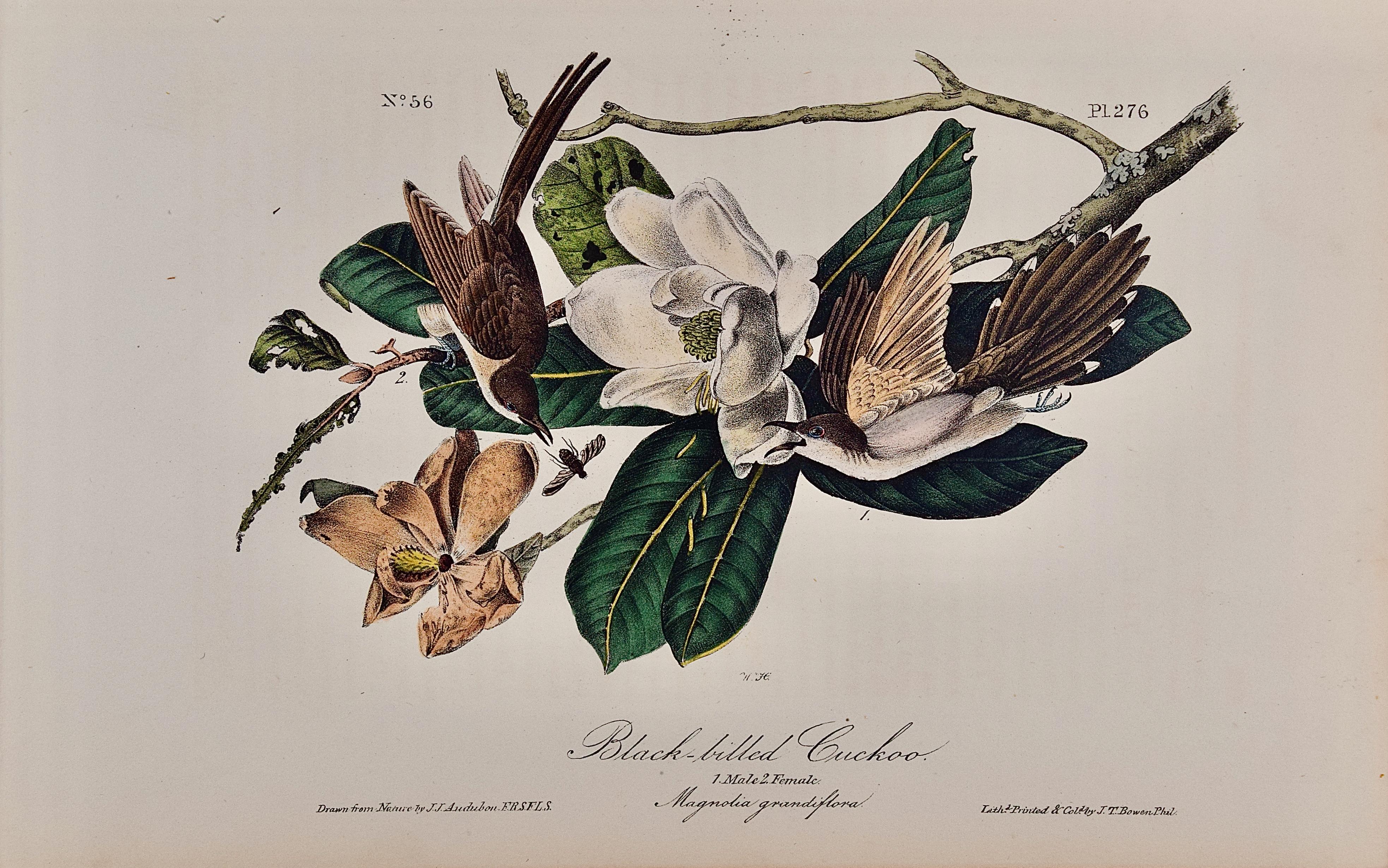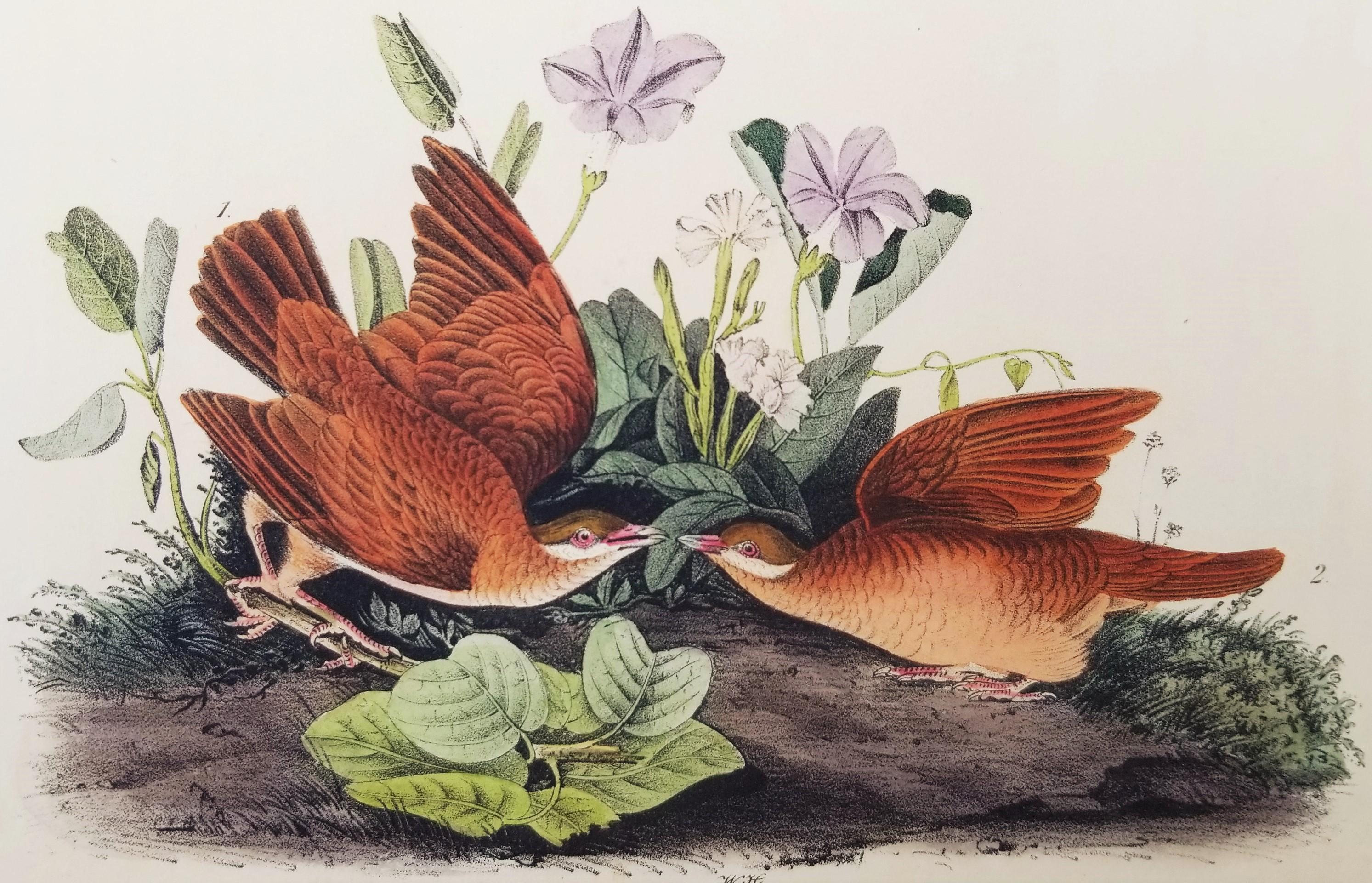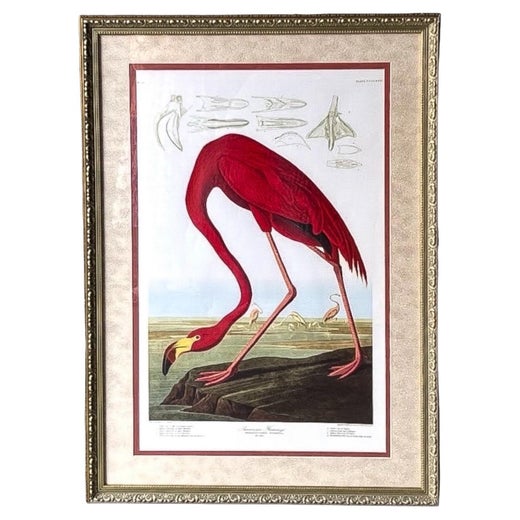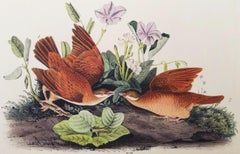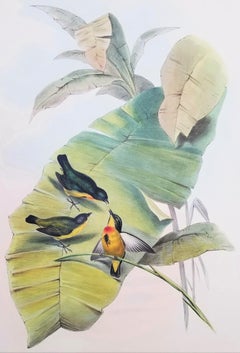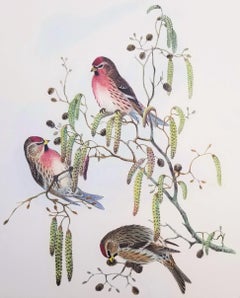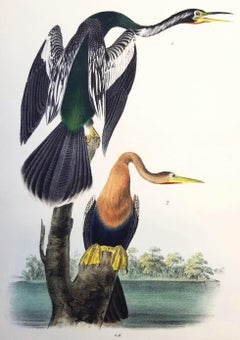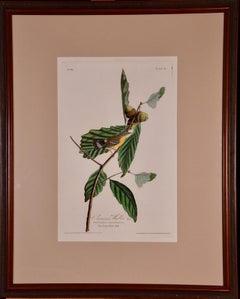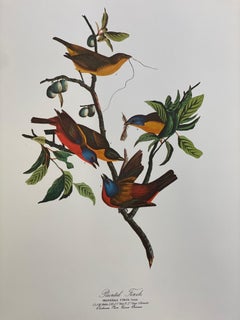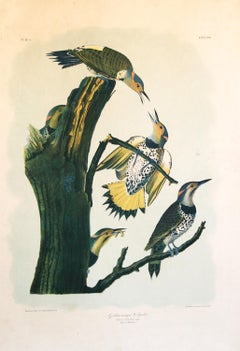Items Similar to Bonaparte’s Flycatching-Warbler (Great Magnolia) /// Ornithology Bird Audubon
Want more images or videos?
Request additional images or videos from the seller
1 of 15
John James AudubonBonaparte’s Flycatching-Warbler (Great Magnolia) /// Ornithology Bird Audubon1840-1844
1840-1844
$500
£378.42
€434.32
CA$712.29
A$772.50
CHF 405.74
MX$9,383.29
NOK 5,077.25
SEK 4,780.52
DKK 3,243.88
About the Item
Artist: John James Audubon (American, 1785-1851)
Title: "Bonaparte’s Flycatching-Warbler (Great Magnolia)" (Plate 73, No. 15)
Portfolio: The Birds of America, First Royal Octavo Edition
Year: 1840-1844
Medium: Original Hand-Colored Lithograph on wove paper
Limited edition: approx. 1,200
Printer: John T. Bowen, Philadelphia, PA
Publisher: John James Audubon and J.B. Chevalier, New York, NY and Philadelphia, PA
Sheet size: 10.5" x 6.5"
Image size: 7.5" x 5.63"
Condition: Minor area of discoloration upper right corner. In excellent condition with strong colors
Notes:
Lithography and hand-coloring by American artist John T. Bowen (1801-c.1856). Comes from Audubon's famous seven volume portfolio "The Birds of America", First Royal Octavo Edition (1840-1844), which consists of 500 hand-colored lithographs.
Based on a composition painted on August 13, 1821.
The Canada warbler is a small boreal songbird of the New World warbler family. It summers in Canada and northeastern United States and winters in northern South America.
To make 'The Birds of America' more affordable and widely available, in 1839 John James Audubon began the first octavo edition, a smaller version of the folio which was printed and hand-colored by J. T. Bowen in Philadelphia. Employing a new invention, the camera lucida, the images were reduced in size, rendered in intermediate drawings by John James Audubon and his son John Woodhouse, and then drawn onto lithographic stones. These miniatures exhibit a remarkable amount of attention to quality and detail, as well as a meticulous fidelity to the larger works. Some compositional changes were made in order to accommodate the smaller format. Like the Havell edition, John James Audubon’s first octavo edition was sold by subscription and distributed in parts, five at a time. However, the octavo editions were issued in proper phylogenic, or species order. These prints also bear the plate number in the upper right-hand corner and the subscription number in the upper left. The first edition of approximately 1,200 sets was completed in five years from 1839 to 1844. A total of 500 images comprise the First Royal Octavo Edition.
Biography:
John James Audubon (April 26, 1785, Les Cayes, Saint-Domingue (later Haiti) – January 27, 1851 (aged 65) Manhattan, New York, U.S.), born Jean-Jacques Audubon, was an American ornithologist, naturalist, and painter. He was notable for his expansive studies to document all types of American birds and for his detailed illustrations that depicted the birds in their natural habitats. His major work, a color-plate book entitled The Birds of America (1827–1839), is considered one of the finest ornithological works ever completed. Audubon identified 25 new species.
- Creator:John James Audubon (1785-1851, American, French)
- Creation Year:1840-1844
- Dimensions:Height: 10.5 in (26.67 cm)Width: 6.5 in (16.51 cm)
- Medium:
- Movement & Style:
- Period:
- Condition:
- Gallery Location:Saint Augustine, FL
- Reference Number:1stDibs: LU121212885922
John James Audubon
John James Audubon (April 26, 1785, Les Cayes, Saint-Domingue (later Haiti) – January 27, 1851 (aged 65) Manhattan, New York, U.S.), born Jean-Jacques Audubon, was an American ornithologist, naturalist, and painter. He was notable for his expansive studies to document all types of American birds and for his detailed illustrations that depicted the birds in their natural habitats. His major work, a color-plate book entitled The Birds of America (1827–1839), is considered one of the finest ornithological works ever completed. Audubon identified 25 new species.
About the Seller
5.0
Platinum Seller
Premium sellers with a 4.7+ rating and 24-hour response times
Established in 1978
1stDibs seller since 2015
1,350 sales on 1stDibs
Typical response time: <1 hour
- ShippingRetrieving quote...Shipping from: Saint Augustine, FL
- Return Policy
Authenticity Guarantee
In the unlikely event there’s an issue with an item’s authenticity, contact us within 1 year for a full refund. DetailsMoney-Back Guarantee
If your item is not as described, is damaged in transit, or does not arrive, contact us within 7 days for a full refund. Details24-Hour Cancellation
You have a 24-hour grace period in which to reconsider your purchase, with no questions asked.Vetted Professional Sellers
Our world-class sellers must adhere to strict standards for service and quality, maintaining the integrity of our listings.Price-Match Guarantee
If you find that a seller listed the same item for a lower price elsewhere, we’ll match it.Trusted Global Delivery
Our best-in-class carrier network provides specialized shipping options worldwide, including custom delivery.More From This Seller
View AllKey-West Dove /// Ornithology Bird John James Audubon Shorebird Flowers Plant
By John James Audubon
Located in Saint Augustine, FL
Artist: John James Audubon (American, 1785-1851)
Title: "Key-West Dove" (Plate 282, No. 57)
Portfolio: The Birds of America, First Royal Octavo Edition
Year: 1840-1844
Medium: Origin...
Category
1840s Victorian Animal Prints
Materials
Watercolor, Lithograph
Myzanthe Ignipectus (Fire-breasted Flowerpecker) /// John Gould Ornithology Bird
By John Gould
Located in Saint Augustine, FL
Artist: John Gould (English, 1804-1881)
Title: "Myzanthe Ignipectus (Fire-breasted Flowerpecker)" (Vol. 2, Plate 40)
Portfolio: The Birds of Asia
Year: 1850-1883
Medium: Original Hand-Colored Lithograph on wove paper
Limited edition: approx. 235
Printer: Hullmandel & Walton, T. Walter or Walter & Cohn, London, UK
Publisher: Taylor and Francis, John Gould, London, UK
Reference: Anker No. 178; Nissen No. IVB 368; Sauer No. 17, Zimmer page 258; Wood page 365; Sitwell page 102
Sheet size: 21.38" x 14.57"
Image size: 16" x 9.75"
Condition: Light toning to sheet. Has been professionally stored away for decades. In excellent condition with strong colors
Extremely rare
Notes:
Provenance: private collection - Aspen, CO. Lithography and hand-coloring by John Gould and English artist Henry Constantine Richter (1821-1902). Comes from Gould's seven volume "The Birds of Asia", (1850-1883) (First edition), which consists of 530 hand-colored lithographs. Other contributing lithographers were German artist Joseph Wolf (1820-1899) and Irish artist William Hart (1830-1908). "The Birds of Asia" was Gould's last work before his death. Gold gilded edges as issued.
The fire-breasted flowerpecker is a species of bird in the family Dicaeidae found in the Indian Subcontinent and Southeast Asia. Like other flowerpeckers, this tiny bird feeds on fruits and plays an important role in the dispersal of fruiting plants.
Biography:
John Gould FRS (14 September 1804 – 3 February 1881) was an English ornithologist and bird artist. He published a number of monographs on birds, illustrated by plates that he produced with the assistance of his wife, Elizabeth Gould, and several other artists including Edward Lear, Henry Constantine Richter, Joseph Wolf and William Matthew Hart. He has been considered the father of bird study in Australia and the Gould League in Australia is named after him. His identification of the birds now nicknamed "Darwin's finches" played a role in the inception of Darwin's theory of evolution by natural selection. Gould's work is referenced in Charles Darwin's book, "On the Origin of Species".
Category
1850s Victorian Animal Prints
Materials
Watercolor, Lithograph
Aegiothus Linaria (Common Redpoll) /// John Gould Ornithology Bird Lithograph
By John Gould
Located in Saint Augustine, FL
Artist: John Gould (English, 1804-1881)
Title: "Aegiothus Linaria (Common Redpoll)" (Vol. 3, Plate 51)
Portfolio: The Birds of Great Britain
Year: 1862-1873
Medium: Original Hand-Colored Lithograph on wove paper
Limited edition: approx. 750
Printer: Walter or Walter & Cohn, London, UK
Publisher: Taylor and Francis, John Gould, London, UK
Reference: Sauer No. 23; Ayer/Zimmer page 261; Wood page 365; Nissen No. IVB 372; Sitwell page 78
Sheet size: 21.63" x 14.75"
Image size: 13.75" x 10.5"
Condition: Faint UV stain to sheet. Remnants of mounting tape from previous framing on verso. Has been professionally stored away for decades. In excellent condition with strong colors
Very rare
Notes:
Provenance: private collection - Aspen, CO. Lithography and hand-coloring by John Gould and English artist Henry Constantine Richter (1821-1902). Comes from Gould's five volume "The Birds of Great Britain", (1862-1873) (First edition), which consists of 367 hand-colored lithographs. Other contributing lithographers were German artist Joseph Wolf (1820-1899) and Irish artist William Hart (1830-1908). "The Birds of Great Britain" is recognized as Gould's greatest work. Gold gilded edges as issued.
The common redpoll or mealy redpoll is a species of bird in the finch family. It breeds somewhat further south than the Arctic redpoll, also in habitats with thickets or shrubs.
Biography:
John Gould FRS (14 September 1804 – 3 February 1881) was an English ornithologist and bird artist. He published a number of monographs on birds, illustrated by plates that he produced with the assistance of his wife, Elizabeth Gould, and several other artists including Edward Lear, Henry Constantine Richter, Joseph Wolf and William Matthew Hart. He has been considered the father of bird study in Australia and the Gould League in Australia is named after him. His identification of the birds now nicknamed "Darwin's finches" played a role in the inception of Darwin's theory of evolution by natural selection. Gould's work is referenced in Charles Darwin's book, "On the Origin of Species".
Category
1860s Victorian Animal Prints
Materials
Watercolor, Lithograph
American Anhinga - Snake Bird /// John James Audubon Ornithology Natural History
By John James Audubon
Located in Saint Augustine, FL
Artist: John James Audubon (American, 1785-1851)
Title: "American Anhinga - Snake Bird" (Plate 420, No. 84)
Portfolio: The Birds of America, First Royal Octavo Edition
Year: 1840-1844
Medium: Original Hand-Colored Lithograph on wove paper
Limited edition: approx. 1,200
Printer: John T. Bowen, Philadelphia, PA
Publisher: John James Audubon and J.B. Chevalier, New York, NY and Philadelphia, PA
Sheet size: 10" x 6.69"
Image size: 6.63" x 4.63"
Condition: Minor toning to sheet and some faint discoloration in margins. Old glue staining along right binding edge as normal. It is otherwise in very good condition with strong colors
Notes:
Provenance: private collection - Cleveland, OH. Lithography and hand-coloring by American artist John T. Bowen (1801-c.1856). Comes from Audubon's famous seven volume portfolio "The Birds of America", First Royal Octavo Edition (1840-1844), which consists of 500 hand-colored lithographs. The preceding 1836 Havell edition of this work has a different title: "Black-bellied Darter", (Plate: CCCXVI - 396, No. 64).
Based on a drawing inscribed "New Orleans 1822 - redrawn ... 1836". This conspicuous bird had various names including "water turkey" and "Bec à Lancette".
The Anhinga, sometimes called snakebird, darter, American darter, or water turkey, is a water bird of the warmer parts of the Americas. The word anhinga comes from a'ñinga in the Brazilian Tupi language and means "devil bird" or "snake bird".
To make 'The Birds of America' more affordable and widely available, in 1839 John James Audubon began the first octavo edition, a smaller version of the folio which was printed and hand-colored by J. T. Bowen in Philadelphia. Employing a new invention, the camera lucida, the images were reduced in size, rendered in intermediate drawings by John James Audubon and his son John Woodhouse, and then drawn onto lithographic stones. These miniatures exhibit a remarkable amount of attention to quality and detail, as well as a meticulous fidelity to the larger works. Some compositional changes were made in order to accommodate the smaller format. Like the Havell edition, John James Audubon’s first...
Category
1840s Victorian Animal Prints
Materials
Watercolor, Lithograph
Pericrocotus Flammeus (Orange Minivet) /// John Gould Ornithology Animal Bird
By John Gould
Located in Saint Augustine, FL
Artist: John Gould (English, 1804-1881)
Title: "Pericrocotus Flammeus (Orange Minivet)" (Vol. 2, Plate 8)
Portfolio: The Birds of Asia
Year: 1850-1883
Medium: Original Hand-Colored Lithograph on wove paper
Limited edition: approx. 235
Printer: Hullmandel & Walton, T. Walter or Walter & Cohn, London, UK
Publisher: Taylor and Francis, John Gould, London, UK
Reference: Anker No. 178; Nissen No. IVB 368; Sauer No. 17, Zimmer page 258; Wood page 365; Sitwell page 102
Sheet size: 21.38" x 14.57"
Image size: 16.25" x 10"
Condition: Faint UV stain to sheet and light toning at edges. Remnants of mounting tape from previous framing at top edge on verso. Has been professionally stored away for decades. In excellent condition with strong colors
Very rare
Notes:
Provenance: private collection - Aspen, CO. Lithography and hand-coloring by John Gould and English artist Henry Constantine Richter (1821-1902). Comes from Gould's seven volume "The Birds of Asia", (1850-1883) (First edition), which consists of 530 hand-colored lithographs. Other contributing lithographers were German artist Joseph Wolf (1820-1899) and Irish artist William Hart (1830-1908). "The Birds of Asia" was Gould's last work before his death. Gold gilded edges as issued.
The orange minivet is a brightly colored bird in the cuckooshrike family, Campephagidae. It is found all along the Western Ghats and west coast of India and Sri Lanka.
Biography:
John Gould FRS (14 September 1804 – 3 February 1881) was an English ornithologist and bird artist. He published a number of monographs on birds, illustrated by plates that he produced with the assistance of his wife, Elizabeth Gould, and several other artists including Edward Lear, Henry Constantine Richter, Joseph Wolf and William Matthew Hart. He has been considered the father of bird study in Australia and the Gould League in Australia is named after him. His identification of the birds now nicknamed "Darwin's finches" played a role in the inception of Darwin's theory of evolution by natural selection. Gould's work is referenced in Charles Darwin's book, "On the Origin of Species".
Category
1850s Victorian Animal Prints
Materials
Watercolor, Lithograph
Roseate Spoonbill /// John James Audubon Natural History Ornithology Water Bird
By John James Audubon
Located in Saint Augustine, FL
Artist: John James Audubon (American, 1785-1851)
Title: "Roseate Spoonbill" (Plate 362, No. 73)
Portfolio: The Birds of America, First Royal Octavo Edition
Year: 1840-1844
Medium: Original Hand-Colored Lithograph on wove paper
Limited edition: approx. 1,200
Printer: John T. Bowen, Philadelphia, PA
Publisher: John James Audubon and J.B. Chevalier, New York, NY and Philadelphia, PA
Sheet size: 6.75" x 10.44"
Image size: 5" x 7.63"
Condition: In excellent condition
Very rare
The "Roseate Spoonbill" is one of the very top, absolute most desirable birds from Audubon's famous "Birds of America" series
Notes:
Provenance: private collection - Fleming Island, FL. Lithography and hand-coloring by American artist John T. Bowen (1801-c.1856). Comes from Audubon's famous seven volume portfolio "The Birds of America", First Royal Octavo Edition (1840-1844), which consists of 500 hand-colored lithographs.
Based on a composition painted in Florida in 1831 or 1832. "This beautiful and singular bird" was prized for its wings and tail feathers which were made into fans in St. Augustine.
The roseate spoonbill is a gregarious wading bird of the ibis and spoonbill family, Threskiornithidae. It is a resident breeder in both South and North America. The roseate spoonbill's pink color is diet-derived, consisting of the carotenoid pigment canthaxanthin, like the American flamingo.
To make 'The Birds of America' more affordable and widely available, in 1839 John James Audubon began the first octavo edition, a smaller version of the folio which was printed and hand-colored by J. T. Bowen in Philadelphia. Employing a new invention, the camera lucida, the images were reduced in size, rendered in intermediate drawings by John James Audubon and his son John Woodhouse, and then drawn onto lithographic stones. These miniatures exhibit a remarkable amount of attention to quality and detail, as well as a meticulous fidelity to the larger works. Some compositional changes were made in order to accommodate the smaller format. Like the Havell edition, John James Audubon’s first...
Category
1840s Victorian Animal Prints
Materials
Watercolor, Lithograph
You May Also Like
Swainson's Warbler: A Framed Original Hand-colored Audubon Folio Bird Engraving
By John James Audubon
Located in Alamo, CA
This is an original John James Audubon hand-colored folio sized lithograph entitled "Swainson's Warbler, Male, Sylvicola Swainsonia, Tree: Vulgo, White Oak", No. 10, Plate 50, from A...
Category
Mid-19th Century Naturalistic Animal Prints
Materials
Engraving
Bay-breasted Warbler, No. 14, Plate LXIX
By John James Audubon
Located in Austin, TX
John James Audubon (1785 - 1851)
"Bay-breast Warbler"
No. 14, Plate LXIX
Hand Colored Engraving
Part of the Havell Edition (1827 - 1838)
Framed: 49” x 3...
Category
19th Century Animal Drawings and Watercolors
Materials
Engraving
Price Upon Request
Large Classical Bird Color Print after John James Audubon - Painted Finch
By After John James Audubon
Located in Cirencester, Gloucestershire
Classical Bird print,
after John James Audubon,
printed by Harry N. Abrams, Publishers, New York
unframed, 17 x 14 inches color print on pap...
Category
20th Century Victorian Animal Prints
Materials
Color
$148 Sale Price
20% Off
Golden Winged Woodpecker by J.J. Audubon Bien Edition 1860
By John James Audubon
Located in Paonia, CO
The Golden Winged Woodpecker, Plate 273 Picus auratus, Linn. The current name, Northern Flicker, Colaptes auratus. is in good condition. The edges are ragged from age with small areas of paper missing in two places but only on the very edge.
The ” Birds of America” by John James...
Category
1860s Other Art Style Animal Prints
Materials
Lithograph
Black-billed Cuckoo: An Original 1st Ed. Audubon Hand-colored Bird Lithograph
By John James Audubon
Located in Alamo, CA
This is an original 1st octavo edition John James Audubon hand-colored lithograph entitled "Black-billed Cuckoo, 1. Male, 2, Female, Magnolia Grandiflora", No. 56, Plate 276 from Audubon's "Birds of America, lithographed, printed and colored by J. T. Bowen and published in Philadelphia between 1840-1844. It depicts a female black-billed cuckoo perched on a branch of a magnolia tree reaching for a flying insect. The male appears to be in flight in front of magnolia leaves on the right, perhaps after the same insect. Magnolia flowers are depicted, as well.
This original 1st octavo edition hand-colored Audubon Black-billed Cuckoo lithograph is in excellent condition, other than a few tiny spots in the upper margin and a tiny faint spot in the lower inscription area. The sheet measures 6.5" high by 10.13" wide. The original text pages, 300-302, from Audubon's 19th century publication are included with the lithograph.
John James Audubon (1785-1851) was a naturalist and artist. He was initially unsuccessful financially prior to the publication of his famous work “The Birds of America”, spending time in debtor’s prison, once stabbing a disgruntled investor in self-defense. However, his obsession with birds and art motivated him to persist in his goal of documenting every bird in America via his watercolor paintings and publishing his works for all to enjoy. Audubon's first illustrations were published in a large elephant folio size. Due to their expense they were purchased in rather small numbers by the wealthy. To reach a larger audience, Audubon, with the help of his sons and J. T. Bowen, published a smaller octavo sized lithograph version, which were much more affordable.
With the success of his bird projects, Audubon then turned his attention to four-legged animals. He explored the Missouri River in 1843 sketching the four-legged animals he encountered in their natural setting. His expedition covered some of the same regions recently explored by Lewis and Clark, traveling from present day Alaska to Mexico. Audubon realized that this was an opportunity to document these animals in the still relatively pristine American wilderness, before man encroached on their environment.
Between 1845 and 1848, Audubon and his sons John Woodhouse Audubon and Victor Gifford Audubon produced a set of elephant folio sized lithographs that were primarily engraved and hand colored by J. T. Bowen in Philadelphia. The publication, which included text descriptions of the animals was published 3 years before Audubon died. As with the birds, this was followed by a three-volume set of 155 octavo-sized plates entitled “The Quadrupeds of North America” completed and published by Audubon’s sons, John, Jr. and Victor.
Audubon prints continue to be popular and a wise investment. The double elephant folio set...
Category
Mid-19th Century Naturalistic Animal Prints
Materials
Lithograph
Golden-winged Woodpecker: First Octavo Edition Audubon Hand-colored Lithograph
By John James Audubon
Located in Alamo, CA
This is an original John James Audubon hand-colored royal first octavo edition lithograph entitled "Golden-winged Woodpecker, 1. Male, 2. Female2", No. 55...
Category
Mid-19th Century Naturalistic Animal Prints
Materials
Lithograph
More Ways To Browse
Damien Hirst Lithograph
Picasso Print Bull
Polo Etchings
Red Dog Rodrigue
Siamese Cat Art
Antique African Animal Art
Apple Think Different Poster
Colombe Picasso
Dali Zodiac Prints
Dali Zodiac
El Toro
Gould Richter Hummingbirds
Hunt Slonem Bunny Print
Hunt Slonem Lithograph
Japanese Print Animals
Josh Keyes
Jungle Lithograph
Pablo Picasso La Pique
